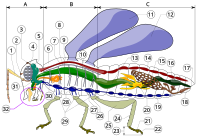
Photo from wikipedia
Plant sap is a nutritionally unbalanced diet that constitutes a challenge for insects that feed exclusively on it. Sap-sucking hemipteran insects generally overcome this challenge by harboring beneficial microorganisms in… Click to show full abstract
Plant sap is a nutritionally unbalanced diet that constitutes a challenge for insects that feed exclusively on it. Sap-sucking hemipteran insects generally overcome this challenge by harboring beneficial microorganisms in their specialized symbiotic organ, either intracellularly or extracellularly. Genomic information of these bacterial symbionts suggests that their primary role is to supply essential amino acids, but empirical evidence has been virtually limited to the intracellular symbiosis between aphids and Buchnera. Here we investigated the amino acid complementation by the extracellular symbiotic bacterium Ishikawaella harbored in the midgut symbiotic organ of the stinkbug Megacopta punctatissima. We evaluated amino acid compositions of the phloem sap of plants on which the insect feeds, as well as those of its hemolymph, whole body hydrolysate, and excreta. The results highlighted that the essential amino acids in the diet are apparently insufficient for the stinkbug development. Experimental symbiont removal caused severe shortfalls of some essential amino acids, including branched-chain and aromatic amino acids. In vitro culturing of the isolated symbiotic organ demonstrated that hemolymph-circulating metabolites, glutamine and trehalose, efficiently fuel the production of essential amino acids. Branched-chain amino acids and aromatic amino acids are the ones preferentially synthesized despite the symbiont’s synthetic capability of all essential amino acids. These results indicate that the symbiont-mediated amino acid compensation is quantitatively optimized in the stinkbug-Ishikawaella gut symbiotic association as in the aphid-Buchnera intracellular symbiotic association. The convergence of symbiont functions across distinct nutritional symbiotic systems provides insight into how host-symbiont interactions have been shaped over evolutionary time.
Journal Title: Frontiers in Physiology
Year Published: 2022
Link to full text (if available)
Share on Social Media: Sign Up to like & get
recommendations!